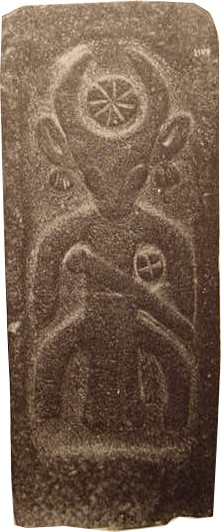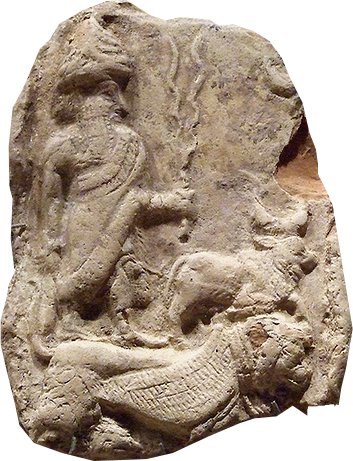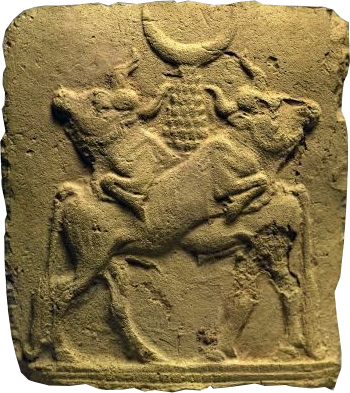Ancient Psychedelia: Alien Gods & Mushroom Goddesses
Online Book - Chapter 9, Page 142
Back to Online Book Mainpage / Next Page (Chapter 9, Page 143)
| Though it’s also possible that this is Dionysus, as this same deity wore a Phrygian cap and his adherents did as well (22), Dionysus myths are usually told without any reference to emasculation or hermaphroditism. At this later stage, during the Hellenic era, he is a crossdresser who is empathic to women, as a celebrant of their fertile aspects. In another view, it is s/he who is the fertile one, being the mushroom, and the female dancers are the maenads who excite him to ejaculate the spores all over the garden. Similarly, it can be seen that the maenads are the spores emitting from the mushroom which make up the “fairy rings,” as they can be seen to be “dancing in a circle around the mushroom” in a mythical allegorical sense. Baal was given the epithet “Lord of Rain and Dew,” and also “Lord of the Heavens.” (23) Baal-Hadad was often sometimes depicted as a ram or a bull. In most Semitic languages, such as Ugaritic, Phoenician, Hebrew, Amorite, and Aramaic, the word baʿal signified “owner,” “lord,” a “master,” or “husband.” Baal was the same god as Marduk in Babylonia and like Marduk, started off as a younger god who succeeded to the head of the pantheon. E.O. James, in Cult of the Mother Goddess writes: “Once he was established as the personification of the storm, the wind and the clouds, and the controller of the rainfall and the growth of the crops, Baal became the counterpart of Tammuz as the fertility-god of vegetation whose descent into the nether regions cause the languishing of the earth, though in a modified guise peculiar to this complex and still very fragmentary mythology.” (24) Baal was paired with Anat in Syria and his epithet was “the Rider of the Clouds.” In Syria, rain was the primary source of fertility, not a river like the Nile in Egypt or the Euphrates in Mesopotamia. Therefore, because he was equated with the rainfall which gave life to the earth he was “lord over the furrows of the field” and “Prince, lord of the Earth.” (25) Baal, being a storm god, who provides rain and fertilizing properties for the earth, had as his adversary, Mot, who represented drought and death of vegetation in the wintertime. Mot’s power over the earth was expressed in the Anat-Baal texts as, “wandering over every mountain to the heart of the earth, every hill to the earth’s very bowels, turning them into desolation by robbing all living things of the breath of life.” (26) The term Baal was also used to denote gods foreign to Israel as well as being incorporated into the names of Israelites (e.g. Jerubba’al, Meribaal). Baal is known as a bull god as well and Yahweh was also referred to as the bull (or calf) in I Kings 12:28, when King Jeroboam went to the people to appease them: “And this was the plan he devised; he made two golden calves, and said to the men of Israel, “Here are your gods; the same gods that rescued you from the land of Egypt; no need to make pilgrimage to Jerusalem anymore.” (27) |
Baal-Hadad was the Amorite version of Baal-Zephon (“Lord of the North”) and was mentioned in Ugaritic, Egyptian and Phoenician texts as a sea and storm god. His abode was Mount Sapan (hence Baal-Zaphon) in Northern Syria. He was the son of Dagan or El. As Ba’al or “Lord,” he was also Ba’al Hazor in Palestine, Baal-Sidon and Baal of Tyre (Melkart) in Lebanon. His name as Ba’al-Zebul means “Lord of the Mansion” (of the North) and this was later altered in Philistine. (28) He is most often remembered as the “dark lord” who brought disease, by the later patriarchal Hebrews and even later Christians due to his affiliation with the Philistine city of Ekron where he is mentioned in the Bible (II Kings I. 2, 3, 6, 16) in connection with the illness of Ahaziah, king of Israel, in 842 BC, where he is honored as the “Lord of the Flies,” which is an appropriate title for the god, in all truth. (29) In steles of Baal-Adad, from Syria from 1300 BC, we see him depicted as a bull with an orb above his head (14d), as a man with a mushroom shaped head wielding a thunderbolt, with a bull beside him (14e), and from 1500 BC, as two bulls with an upright crescent (14f).    Left to Right: (14d) Baal-Adad, Damascus Museum c. 1300 BC Middle (14e) Baal-Adad Right; (14f) Israel Museum c. 1500 BC The A. muscaria is known to attract flies who seem to get “drunk” or intoxicated on its juices when water sits on the cap and collects as the cap turns upright in the mushroom’s final stages before decay. This appears to be a definite part of the changeover from the mushroom as a healing deity to the “devil” or a sickness inducing deity, (daemon). Later, Archers like Apollo were thought to have dualistic healing and disease-causing attributes. A few years back during November, when I went out foraging for Amanitas in the Sonoma hills, I was getting ready to pick one and there were all kinds of flies circling above this one cap which was upturned like a grail cup. As I reached for it and pulled it up, all the flies darted towards my face and flew into my eyes and mouth. It was not pleasant, but it was a subtle reminder to me, to be conscious of nature at all times and respectful to all the creatures. I was taking the flies’ libation bowl and I had not given the proper respects. (22) Charles Picard, "Dionyos Mitrephoros": 707-721, in Melanges Gustave Glotz, II (Paris, Presses Universitaires de France, 1932 (23) https://www.britannica.com/topic/Baal-ancient-deity (24) Cult of the Mother Goddess, p. 70 (25) ibid, p. 71; Anat-Baal Texts (A.B.), II, 39ff.; 49: IV, 27, 29' Krt text, 126, col. iii, I 5ff (26) Cult of the Mother Goddess, p. 72-73; I, Anat-Baal Texts, II, 15-20 (27) ibid, p. 79 (28) White Goddess, p. 440 (29)http://www.jewishencyclopedia.com/articles/2255-baal-zebub |
Go Back to Page 141